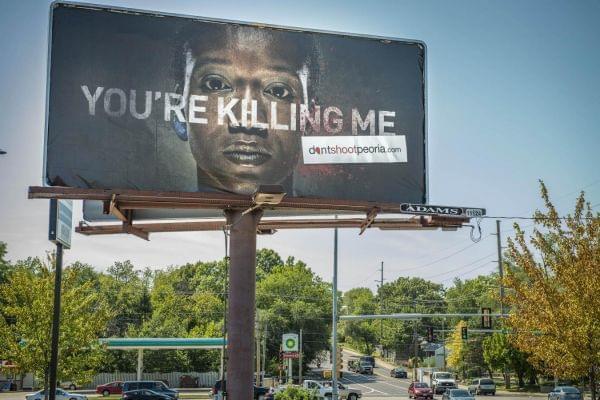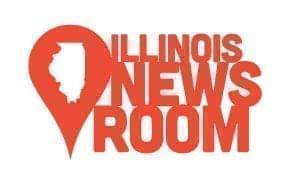How To Stop Gun Violence? Just Ask

Peoria launched its 'Don't Shoot' initiative with a graphic billboard campaign. Peoria Public Radio
Conversations around gun violence often revolve around long-term solutions, like improving schools or the local economy.
But even if those things were easy — and they’re not — it would take a generation to realize the benefits.
And for the Illinoisans living and dying in these communities — mostly low-income, black communities — they don’t have time to wait.
Cities like Peoria have had hundreds of shootings in the last few years. Mayor Jim Ardis says people are worried.
“I mean, the parents are worried about having their kids outside playing,” he says.

Mayor Jim Ardis in his downtown Peoria office.
So a number of years ago, Ardis and Peoria law enforcement teamed up with community leaders to try something different.
They call it “Don’t Shoot.” Champaign-Urbana followed with “CU Fresh Start.” And now Springfield is launching “Focused Deterrence.“ Three names for the same simple set of ideas.
It starts from the fact that most street violence is caused by a relatively small number of people, who run together in gangs or other small groups. They also happen to be the people most likely to be victims of shootings, too.
The cities bring them together at what’s called a “call in,” and they deliver a three-part message:
1) You’re creating havoc in the community.
2) If you want to leave gang life, we will help you.
3) But no matter what you choose, you must put down your guns.
As First Assistant U.S. Attorney Patrick Hansen puts it, “If you don't do this, bad things can happen. And we're here to tell you that we will enforce the laws.”
Having the U.S. Attorney’s office be part of the law enforcement message alongside local police and county prosecutors is meant to convey that the government isn’t playing around. The federal sentencing regime is far more strict, with fewer opportunities for early release than state prison.
”I think it really does surprise people at how much time they could actually be looking at with three prior violent felonies,” Hansen says. “That could be life sentence for somebody that's carrying a gun.”
But the promise of swift and certain punishment is only part of the message delivered at a call in. There’s also a strong community component.
The Call In
Springfield’s first call in was held Wednesday evening, in a bland meeting room downtown. (Authorities allowed two reporters to witness the event on two conditions: no electronic recording and no publishing the names of anyone who wasn’t a government official.)
Eight men — all young, all black, all suspected of being involved with gun violence — were led into the room where police, prosecutors, and a number of invited guests from the community were gathered.
They first heard from the police chief, the mayor, the U.S. attorney, and the state’s attorney. Then came a minister, two former gang members, two parents whose children were murdered, and a man whose job is to connect those who are interested with social services.
The eight men sat in a semicircle. Some hunched forward, hanging their heads. Others slouched back. A few seemed to laugh at inappropriate times.
But a few things seemed to get their attention. One was the warning from U.S. Attorney John Childress: “If you and I see each other, you have made a very bad decision.”
Another was a grieving mother whose only son was shot to death. She says she hadn’t wanted to come to the meeting, but then thought of the possibilities — what if someone had delivered this kind of message to the man who killed her boy?
At one point, she got close to one of the participant’s faces and snapped, “Do you want your momma to see you in a casket?” He shook his head no.
People who’ve been through call ins say it’s hard to judge right away whether the message got through.
Maintaining Focus
“That night can be a very emotional time,” says Tracy Parsons, who has helped coordinate Champaign-Urbana’s version of the program.
He says after CU Fresh Start’s first call in, everyone signed up for social services.
He recalls thinking: Great! We got nine guys! They all signed up! We’re moving in the right direction. “And then we found out really quickly that it was just an emotional response for those guys as it was for us,” Parsons says.
“If you have a guy who's been living a life of criminality — to think we're going to change them in a year, 6 months, that's not very realistic,” he says.
Nevertheless, Parsons and others involved with these programs say the offer of support — like help getting a job — is important, because it shows that the community is sincere about getting people on a different path.
But ultimately, it’s all a means to another end.
“This is really about stopping the shooting incidents,” Parsons says. “We’ll continue working on those other social and economic issues. But this main focus is to stop the shootings.”
Getting Community On Board
Pastor Martin Johnson says he didn’t know what to expect when he was invited to attend Peoria’s first call in. He says he was told it was a program to give young people caught up in violence another chance. As the founder of New Beginnings Ministries of Peoria, he was told his presence as a community leader would be helpful.
He was not impressed.

Pastor Martin Johnson in front of his New Beginnings Ministries of Peoria.
“The very first one, it was sort of talking down to them — the individuals who create the acts of violence,” Johnson says. “I’m not minimizing their responsibility in our community, but I didn't quite understand the end objective and the motivation to get individuals to change.”
He shared his observations with authorities — that there was too little to motivate people to turn away from crime — and says they made adjustments.
But that dynamic has played out elsewhere, too.
Parsons, in Champaign, says he’s found that aspect of the call ins to be a “tough visual”: “Anywhere from 10 to 15 African American males being brought in front of the community,” where “most of the law enforcement entities are made up of the white community more than African-Americans.”
Still, Parsons, says he appreciates the fact that the program is tightly focused on people responsible for violence in the community, contrasting that with the casting-a-wide-net approach used in some low-income and black communities.
“When these types of crimes and activities or spiking activity occurs, and if I'm as an African-American male driving through or in those areas, I'm just as likely to be a suspect as anyone,” he says.
David Kennedy, one of the creators of this approach and its most prominent evangelist, argues that when the focused deterrence model really works, it can help repair the troubled relationship between law enforcement and some of America’s most distressed communities.
He laid out his vision in 2011 on NPR’s Fresh Air: “If we play against type — so if we not only stop doing this damage in the neighborhood, if there's a different way to stop the crime and the violence without locking people up, not only do we not do that unintended damage, but we show the neighborhood that what it thinks of the cops and the outside is wrong and taking the crime seriously, while also taking seriously that we have to stop locking everybody up, tells the community a new story and that releases enormous good things.”
How Do You Measure Success?
Springfield’s Focused Deterrence, CU Fresh Start, and Peoria’s Don’t Shoot are based on a model that’s been tried and tested across America since the mid-1990s.
Peoria has had the program the longest, and saw positive early results, though shootings have gone up and down.
But some involved with the program, like Nathaniel Terry, say the numbers don’t tell the whole story.
“Sometimes, you can reach people,” Terry says. “A couple guys out of the program came to my church, got involved, and got jobs.”
Terry lives in Peoria. Today he’s got a good job, and runs a prison ministry on the side. But in the past, he was a ranking member of a major gang, where he did enough bad stuff to spend a decade in a state prison.
Now, he tries to reach the young men at Peoria’s call ins.
“You know, if it's like a thousand men, maybe sometimes you can reach one or two. And it's worth it even if you reach just that one or two,” Terry says.
Still, just about everyone involved with these programs says they’re not enough — our society needs to address those bigger issues of families and schools and distressed communities.
But no one’s holding their breath for that.
And until it does happen, cities like Champaign, Peoria, Springfield and Urbana will keep trying to save their young men, one small group at a time.

Illinois Newsroom is a regional journalism collaboration focused on expanding coverage of education, state politics, health, and the environment. The collaborative includes Illinois Public Media in Urbana, NPR Illinois in Springfield, WSIU in Carbondale, WVIK in the Quad Cities, Tri States Public Radio in Macomb, Harvest Public Media and the Midwest Center for Investigative Reporting. Funding comes from the stations and grants from the Corporation for Public Broadcasting (CPB) and McCormick Foundation.
Links
- Suicide A Driver Of Gun Deaths In Rural America
- How Gun Violence Is Traumatizing Kids And What Schools Can Do About It
- Police Data Show Gun Violence A Chronic, Growing Problem Across Illinois
- ‘Down The Hill:’ Violence Often Rooted In Inequality
- Gun Violence In North And South Peoria; Hate In The Republican Party; Death Penalty
- Lawmaker Asks IL House To Agree With Rauner On Gun Bill Changes
- Rauner Proposes Bringing Back Death Penalty, Other Gun Measures, in Amendatory Veto
